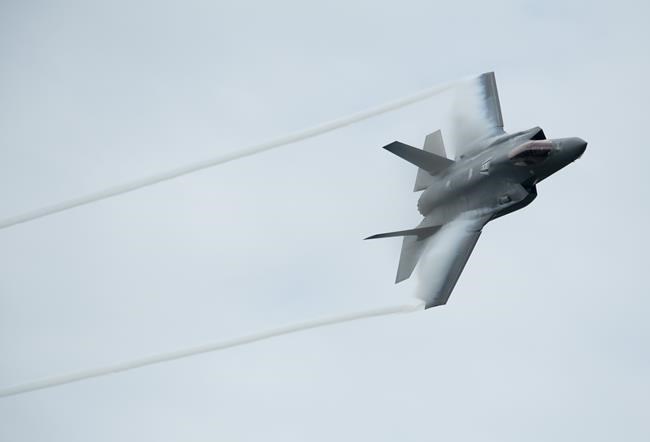OTTAWA — The Department of National Defence recently received quiet approval to spend $7 billion on 16 F-35 fighter jets and related gear.
Two defence sources, who spoke on the condition of anonymity to discuss matters not yet made public, said a funding request sent to the Treasury Board got the green light earlier this month.
The Canadian Press also viewed a document summarizing this request to Treasury Board, which is the department that controls the federal purse strings, and independently verified its accuracy.
The funding approval came after months of negotiations with the U.S. government and Lockheed Martin after the F-35 beat out Sweden's Saab Gripen in a competition earlier this year.
While the federal government has said it plans to buy 88 new fighter jets to replace its aging CF-18s between 2026 and 2032, the sources said Canada will be purchasing F-35s in blocks over the next few years.
Canada needed to make an initial order by the end of the calendar year to ensure its planned delivery schedule remains on track, they added.
The Treasury Board approval covers an initial set of 16 F-35s, manufactured by Lockheed Martin, as well as spare parts, weapons and various startup costs associated with obtaining new jets, such as building new facilities.
The Liberal government was expected to make an announcement two weeks ago, according to sources, but now the news is not expected to be formally announced before January.
Procurement Minister Helena Jaczek's office declined to comment specifically on the Treasury Board approval on Tuesday, referring instead to the overall decision to buy 88 fighter jets.
"As outlined in Canada's defence policy Strong, Secure, Engaged, Canada will be acquiring 88 advanced fighter aircraft," spokesman Olivier Pilon wrote in an email.
"We look forward to providing an update on this important project shortly."
Lockheed Martin declined to comment. So did the U.S. Defense Department's F-35 office, which is responsible for the stealth fighter program. They instead referred questions to the Canadian government.
News of the funding decision caught Saab unawares on Tuesday.
"Given that Saab remains eligible for selection in the formal procurement process, we are surprised by today's media report," Saab Canada spokeswoman Sierra Fullerton said in a statement.
"Saab is committed to the offer we made to the government of Canada, which was significantly less than the $19 billion budgeted for the full 88 aircraft requested.”
Canada's decade-long search for a new fighter jet to replace its aging CF-18s came full circle in March when the Liberal government announced negotiations with U.S. defence giant Lockheed Martin to purchase the F-35.
Officials at the time anticipated talks would take about seven months and result in a final contract by the end of the year.
Yet the Liberal government also emphasized at the time that the negotiations did not mean a deal for the F-35 was done, with the government retaining the option to talk with Saab about its Gripen fighter should discussions with Lockheed Martin stall.
The government had initially anticipated spending $19 billion on Canada's next fighter jet fleet, but it was not evident at the time what would — and would not — be included. Defence Minister Anita Anand said in March that the cost would be "further refined."
The purchase of F-35s in tranches is not unique, says U.S.-based analyst Richard Aboulafia, one of the world's leading F-35 experts.
For example, while Britain previously committed to buying a total of 138 F-35s, its initial order was for only 48. Australia has taken a similar approach by initially ordering only 14 of the stealth fighters before later confirming another 58.
The reasons for such a phased approach vary based on each country's budgetary process and their respective military's ability to accept and support the transition to a new aircraft. It is also based on Lockheed Martin's production schedule and other orders.
Carleton University defence procurement expert Philippe Lagassé, who previously served on an independent panel responsible for monitoring military purchases, said there is a great deal of work that needs to be done before Canada can accept F-35s.
That includes building new infrastructure to house and service the state-of-the-art aircraft, as well as various security upgrades to the military's information networks and other data points to protect the planes and keep them from being compromised.
"The entire strategy around that aircraft involves significant kinds of maintenance, data processing and things of that nature," he said. "That all has to be put in place as you begin to take possession of the aircraft. So this is why they're sequencing it that way."
Defence analyst David Perry of the Canadian Global Affairs Institute agreed that transitioning from CF-18s to F-35s will be a complicated endeavour for the Air Force — but that most of the work can't start until the government confirms a deal.
"So there's an immense amount of work that will officially start once we actually make the official commitment to buy the plane," he said, adding: "Our 40-year-old CF-18s aren't getting any younger."
Stephen Harper's Conservative government first committed to buying 65 F-35s without a competition in 2010, before concerns about the stealth fighter's cost and capabilities forced it back to the drawing board.
The Liberals promised in 2015 not to buy the F-35, but to instead launch an open competition to replace the CF-18s. They later planned to buy 18 Super Hornets without a competition as an "interim" measure until a full competition could be launched.
Some at the time questioned that plan, suggesting the Liberals were trying to find a way to lock Canada into the Super Hornet without opening itself up to a legal challenge from Lockheed Martin or any other jet makers.
But the government cancelled the plan after Boeing launched a trade dispute with Montreal aerospace firm Bombardier. Ottawa initiated the current bidding process in July 2019, at which point the Super Hornet and F-35 were allowed to compete.
In the meantime, the government has been forced to invest hundreds of millions of additional dollars into the CF-18 fleet to keep it flying until a replacement can be delivered. By 2032, the CF-18s will have been around for 50 years.
The Canadian Press reported last week that Canada will not send fighter jets to patrol NATO airspace for Russian incursions next year, the first time that Canadian CF-18s will be absent from the skies over Europe since 2017.
The decision was partly blamed on the need to upgrade the CF-18s to ensure they can continue to fight and defend themselves from adversaries until they can be replaced by F-35s.
This report by The Canadian Press was first published Dec. 20, 2022.
Lee Berthiaume, The Canadian Press




